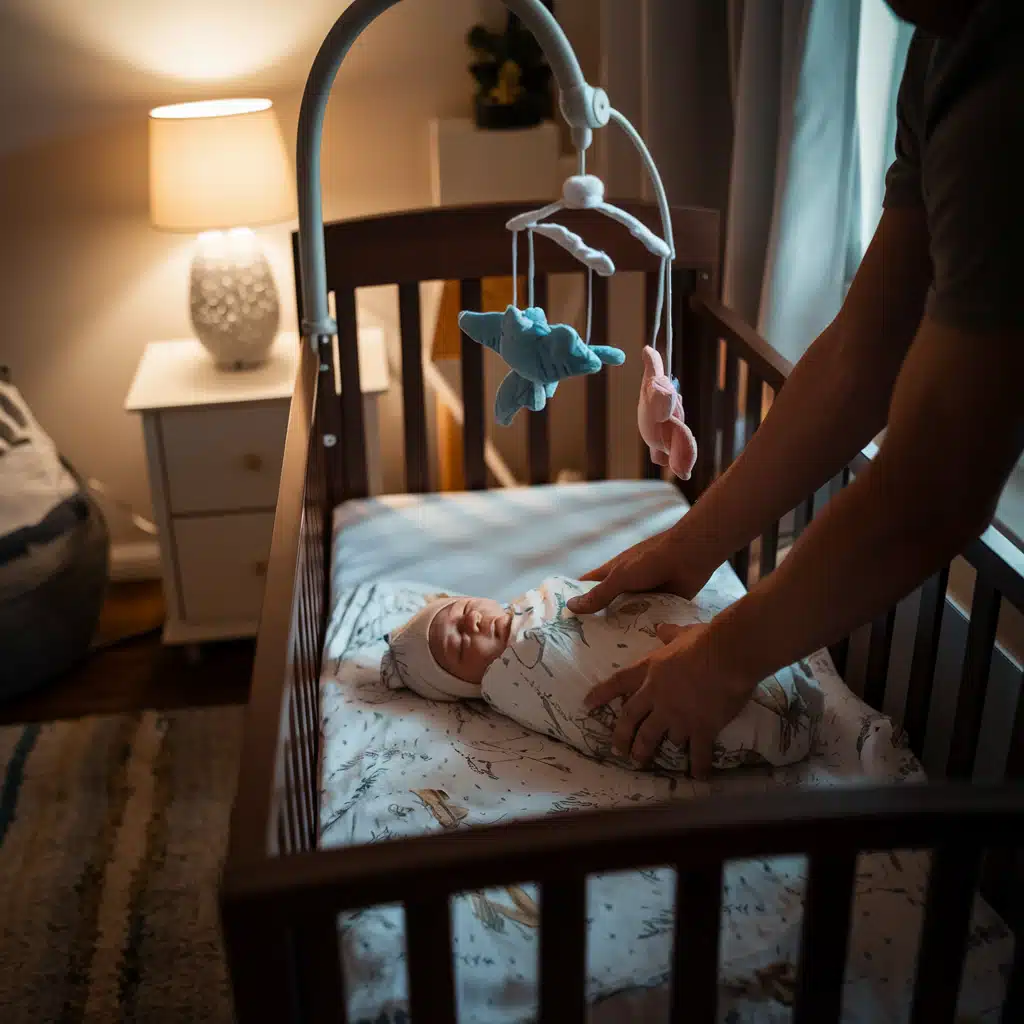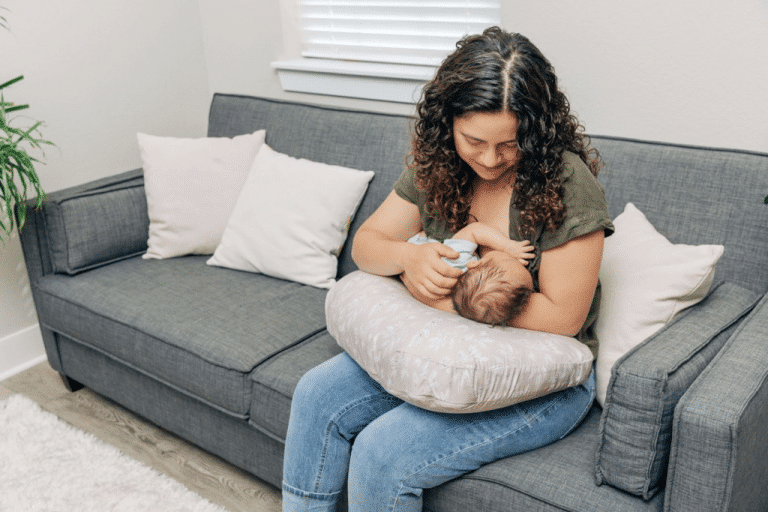Getting your little one to sleep in their crib can feel like a big challenge.
We know because we’ve been through those tough nights when the baby only wanted to sleep next to you.
Many parents tell us they want to make the switch but don’t know where to start.
But moving your baby to their crib doesn’t have to be hard or stressful. However, with the right tips and a bit of patience, you can help your baby feel safe and happy in their new sleep space.
In this post, we’ll share our tried-and-tested steps to make this change easier for both you and your baby.
We’ll look at timing, setting up the right environment, and helpful routines that work.
Why Transition from Co-Sleeping to Crib?
The first few months of the baby’s life, they shared a bed, and it was perfect for those late-night feedings.
But soon, we noticed something had to change. We felt tired during the day, and the baby woke up more often than needed.
Moving your baby to a crib helps in so many ways.
- First, it lets you and your baby get better sleep. When babies sleep in their own space, they learn to fall asleep on their own and stay asleep longer. Plus, they wake up less when you move or make noise in bed.
- For parents, the benefits are clear, too. You get your bed back, sleep better, and can start having proper rest again.
- It’s also good for your relationship with your partner – you can talk, read, or watch TV without worrying about waking the baby.
- The crib also gives your baby a safe place to sleep. They get their own sleeping zone with the right firmness for their growing body. This helps them develop good sleep habits that will last for years.
- And here’s something most parents don’t know: babies who learn to sleep in their own space often become more confident. They figure out how to calm themselves and feel okay being alone for short times.
- It can be tricky at first, but we promise the results are worth it. Both you and your baby will end up sleeping better, feeling happier, and being more rested during the day.
Steps to Get Your Baby to Sleep in Crib After Co-Sleeping
Let’s walk you through this process step by step. We’ve broken it down into smaller parts to make it easier for you to follow.
- Start with Nap Time: Begin with daytime naps in the crib. This helps your baby get used to their new sleep space when they’re naturally more willing to try new things. Put them down for one nap a day in the crib, then slowly add more.
- Make the Crib Cozy: Put a heating pad in the crib for a few minutes before naptime (remove it before putting the baby down). This makes the space warm and welcoming. We also suggest using the same sheet material they’re used to from co-sleeping.
- Keep Familiar Smells Close: Sleep with your baby’s crib sheet for a night before using it. Your scent will help them feel secure. You can also put a shirt you’ve worn near the crib – but not in it – so they can smell you nearby.
- Set Up a Bedtime Pattern: Create a simple routine: bath, soft music, feeding, and gentle rocking. Do this every night at the same time. Babies learn from patterns, and this tells them sleep time is coming.
- Use the Same Room: If you can, put the crib in your room first. This middle step helps babies feel less worried about the change. They know you’re still close by.
- Stay Close But Not Too Close: When you put your baby in the crib, stay where they can see you. Sit nearby and slowly move your chair further away over several nights. This helps them learn to feel safe on their own.
- Be Patient with Progress: Some nights will go better than others. That’s normal. If your baby cries, wait a few minutes before going to them. Sometimes, they need a moment to settle themselves.
- Keep a Schedule: Put your baby down simultaneously each day. A steady schedule helps them know what to expect, which makes them feel more secure about sleeping in their crib.
Right Age for Moving Co-Sleeping to Crib
There is no universally perfect age for this transition, as it depends on the individual needs of each baby.
Most babies are ready for this move between 4 to 6 months old.
By this time, they’ve passed through their earliest growth spurts and can usually sleep longer. They’re also starting to build their own sleep patterns.
Before 4 months, babies often need those frequent night feedings, and staying close makes this easier.
After 6 months, your little one might be more set in their sleep habits, which could make the switch a bit trickier – but not impossible!
Here are some signs that tell you your baby might be ready:
- They can roll over on their own
- They sleep for longer stretches at night
- They don’t need as many night feedings
- They seem more interested in their own space
Remember: Some babies might be ready earlier, while others need more time. What matters most is picking a time when both you and your baby feel ready for this change.
How Long Does It Take to Move Co-Sleeping to a Crib?
Let’s give you the straight facts about timing based on what we’ve seen work with many babies.
The answer is it varies from baby to baby, but most families see progress within 1-2 weeks.
Here’s what the timeline often looks like:
In the first Few Days, Your baby might fuss more than usual. Some babies take to the crib right away, while others need more time to feel comfy in their new space.
Week One: Most babies start getting used to naps in the crib. Night sleep might still be a work in progress, but you’ll notice small wins – maybe they’ll sleep for one long stretch in the crib.
Week Two: This is when things often click. Your baby starts to understand that the crib is their sleep spot. They might still wake up, but settling back down gets easier.
What Can Change The Timeline?
- Your baby’s age when you start
- How long you’ve been co-sleeping
- Your baby’s sleep habits
- How steady you stick to the plan
A Tip from Our Experience: Watch your baby’s signs rather than the clock. Some babies need just a few days, while others might take a month to adjust fully. The key is to stay calm and consistent.
Certain Effective Ways for Comfortable Shift from Co-sleep
We picked these up from both personal experience and what’s worked for other parents.
- Make the crib feel like home
- Put their favorite comfort item near them (if old enough)
- Use the same bedding material they know from your bed
- Keep room temperature just like what they’re used to
- Make sure the mattress feels snug and comfy
- Set Up The Right Mood
- Use soft lighting in the room
- Play white noise or gentle music they know
- Keep the room quiet and peaceful
- Pull curtains to block bright light
- Build trust step by step
- Start with playing in the crib during the daytime
- Make crib time fun with soft toys and songs
- Give lots of hugs and kisses in the crib space
- Stay close by while they get used to it
- Keep things steady
- Follow the same steps each night
- Pick regular times for naps and bedtime
- Don’t skip parts of your routine
- Stay calm even when things get hard
- Make Smart Room Choices
- Put a crib where you can see it from your bed
- Keep it away from air vents or drafts
- Make sure the night light isn’t too bright
- Have everything you need within reach
What is the Right Nighttime for a Crib?
Most babies do well with a bedtime between 7:00 and 8:00 PM. We know this might seem early, but there’s a good reason.
Babies who go to sleep earlier often sleep better and longer.
Signs Your Baby is Ready for Bed
- Rubbing their eyes
- Getting fussy or cranky
- Yawning more than usual
- Less interest in toys or play
- Slower movements
- Heavy eyelids
Tips for Good Timing
- Start bedtime routine 30 minutes before sleep time
- Keep the time steady each night
- Adjust for nap changes during the day
- Look for your baby’s sleepy signals
- Plan the last feeding well before sleep time
Remember: The best time is when your baby shows they’re tired but not overtired. A too-late bedtime often leads to a fussy baby who finds it harder to fall asleep.
How to Manage Common Challenges
| Situation | Approach | Details |
|---|---|---|
| Standing in The Crib | Stay calm and lay them down gently | Pat their back softly, keep lights low and voice quiet |
| Crying at Crib Time | Stay close to the crib at first | Put your hand on their back, speak in soft, soothing tones |
| Night Time Wake-Ups | Keep check-ins brief and quiet | Don’t turn on bright lights, avoid picking up unless needed |
| Sleep-Feeding Connection | Move feeding to start a bedtime routine | Create space between milk and sleep; try other soothing methods |
| Crib Climbing | Return them to the crib without talking | Keep the routine boring; check crib height settings |
| Not Tired at Bedtime | Cut last nap shorter | Add more active play during the day, keep a steady bedtime anyway |
| Separation Worries | Leave your worn shirt nearby | Use the same sleep sounds, keep goodbyes short and sweet |
Conclusion
From our experience, we know that each small win feels like a victory worth celebrating.
Remember, the key points we covered – choosing the right time, following steady steps, and staying patient will help make this change easier.
Every baby moves at their own speed, and that’s perfectly fine.
If you’re starting this switch soon, focus on making the crib a happy place for your baby.
Use the tips we talked about, from keeping your scent nearby to setting up good sleep times. And don’t worry if things take longer than expected.
Want to start tomorrow?
Pick one nap time and try the crib. Small steps lead to big changes!
Frequently Asked Questions
Can I Move My Baby to a Crib if We’ve Been Co-Sleeping Since Birth?
Yes, you can. Start with nap times first. Take small steps each day, and stay patient with the process.
What if My Baby Keeps Waking up More Often in The Crib than in My Bed?
This is normal at first. Keep a steady bedtime routine. Stay calm during wake-ups and give quick comfort without picking them up.
Should I Move the Crib to a Different Room Right Away or Keep It in My Bedroom?
Start with the crib in your bedroom. This helps your baby feel safe while getting used to their new sleep space.
How Do I Know if My Baby Isn’t Ready for The Crib Transition Yet?
Watch your baby’s signs. If they seem very upset for many nights or can’t settle at all, wait a few weeks.













